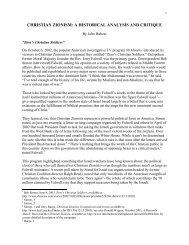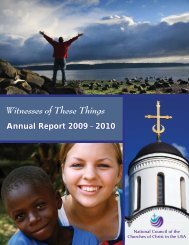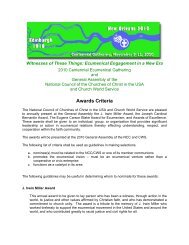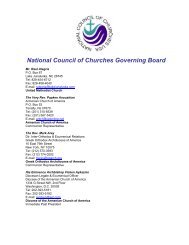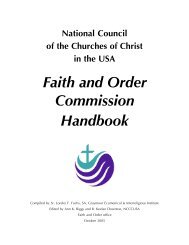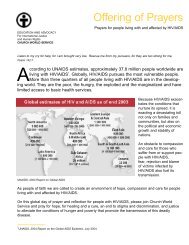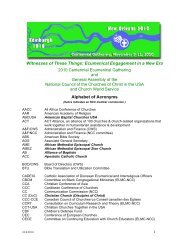Common Agreement on Mutual Recognition of Baptism - National ...
Common Agreement on Mutual Recognition of Baptism - National ...
Common Agreement on Mutual Recognition of Baptism - National ...
Create successful ePaper yourself
Turn your PDF publications into a flip-book with our unique Google optimized e-Paper software.
1240<br />
1241<br />
1242<br />
1243<br />
1244<br />
1245<br />
1246<br />
1247<br />
1248<br />
1249<br />
1250<br />
1251<br />
1252<br />
1253<br />
1254<br />
1255<br />
1256<br />
1257<br />
1258<br />
1259<br />
1260<br />
1261<br />
1262<br />
1263<br />
1264<br />
1265<br />
1266<br />
1267<br />
1268<br />
1269<br />
1270<br />
1271<br />
1272<br />
1273<br />
1274<br />
1275<br />
1276<br />
1277<br />
1278<br />
1279<br />
1280<br />
1281<br />
1282<br />
1283<br />
1284<br />
baptismal rite in this Directory is identical to the pattern in BCW 1993 xxviii . The other significant<br />
change in the 1989 Directory is the inclusi<strong>on</strong> <strong>of</strong> blessing and opti<strong>on</strong>al anointing. Though the<br />
1989 Directory includes a cauti<strong>on</strong> that nothing should overshadow the central act <strong>of</strong> baptizing<br />
with water, other acti<strong>on</strong>s ―deeply rooted in the history <strong>of</strong> baptism‖ are permitted. xxix The 1946<br />
BCW had introduced a Trinitarian blessing following water baptism, but this 1989 development<br />
elaborates <strong>on</strong> that practice, a clear attempt to move toward a shared ecumenical pattern informed<br />
by early church baptismal practice. The service <strong>of</strong> baptism in the 1993 BCW, which is provided<br />
in the appendix and discussed in more detail below, parallels the 1989 Directory, though the<br />
terminology is slightly different.<br />
Method in reform <strong>of</strong> Reformed baptismal rites<br />
The revisi<strong>on</strong>s <strong>of</strong> Reformed baptismal rites in the 20 th century have proceeded differently<br />
for the bodies represented in this dialogue. However, they have shared c<strong>on</strong>cerns to promote 1)<br />
fuller participati<strong>on</strong> <strong>of</strong> the people, 2) greater attenti<strong>on</strong> to the symbolic use <strong>of</strong> water, and 3) greater<br />
appreciati<strong>on</strong> for baptism as central to Christian identity, a mark that both distinguishes the<br />
church from the world and calls the church into missi<strong>on</strong> in and for the world.<br />
While the Roman Catholic church has placed a central focus <strong>on</strong> the restorati<strong>on</strong> <strong>of</strong> the<br />
ancient catechumenate in its baptismal reforms since Vatican II, Reformed churches have<br />
focused <strong>on</strong> revisi<strong>on</strong>s <strong>of</strong> the central baptismal rites and services <strong>of</strong> reaffirmati<strong>on</strong> or renewal <strong>of</strong><br />
baptism. In additi<strong>on</strong>, some Reformed churches have begun exploring the possibilities <strong>of</strong> the<br />
catechumenate model as a process <strong>of</strong> forming new Christians and reiterating baptism as a central<br />
symbol <strong>of</strong> Christian identity. For many Reformed Christians, the catechumenate holds promise<br />
for the following reas<strong>on</strong>s:<br />
It focuses <strong>on</strong> baptism, which has been a central Reformati<strong>on</strong> ―mark <strong>of</strong> the<br />
church‖.<br />
It brings people by stages into the church, providing liturgical boundary markers<br />
to celebrate the gradual inclusi<strong>on</strong> <strong>of</strong> the new Christian into the body <strong>of</strong> Christ.<br />
It provides a clear structure for accompanying people al<strong>on</strong>g the life <strong>of</strong> faith,<br />
through sp<strong>on</strong>sors, catechists, and the whole c<strong>on</strong>gregati<strong>on</strong> praying for the<br />
catechumens.<br />
It is ritually full, something that many seekers and church members are hungering<br />
for. The process <strong>of</strong> leading some<strong>on</strong>e to baptism—and leading a c<strong>on</strong>gregati<strong>on</strong> to<br />
repeated reaffirmati<strong>on</strong>s <strong>of</strong> that baptism—involves the whole pers<strong>on</strong>, body,<br />
mind, and soul.<br />
As Reformed Christians c<strong>on</strong>tinue the work <strong>of</strong> adapting the catechumenate model to a Reformed<br />
c<strong>on</strong>text, several issues are emerging as central to our reflecti<strong>on</strong>:<br />
God’s grace and human resp<strong>on</strong>se. The chief issue in Reformed baptismal<br />
discussi<strong>on</strong> generally c<strong>on</strong>tinues to be how to maintain our historic emphasis <strong>on</strong><br />
baptism as God‘s gracious acti<strong>on</strong> while also attending to the human dimensi<strong>on</strong><br />
<strong>of</strong> the sacrament. Faithful Reformed people disagree <strong>on</strong> how to manage this<br />
balance. This basic issue underlies many <strong>of</strong> the particular questi<strong>on</strong>s that arise in<br />
baptismal debates: for instance, when is it permissible to refuse to baptize<br />
some<strong>on</strong>e? Is any such refusal a denial <strong>of</strong> the generosity <strong>of</strong> God‘s grace? With<br />
regard to the catechumenate, how much should we require <strong>of</strong> those preparing<br />
32



